Table of contents
Who is Our Lady of Sorrows?
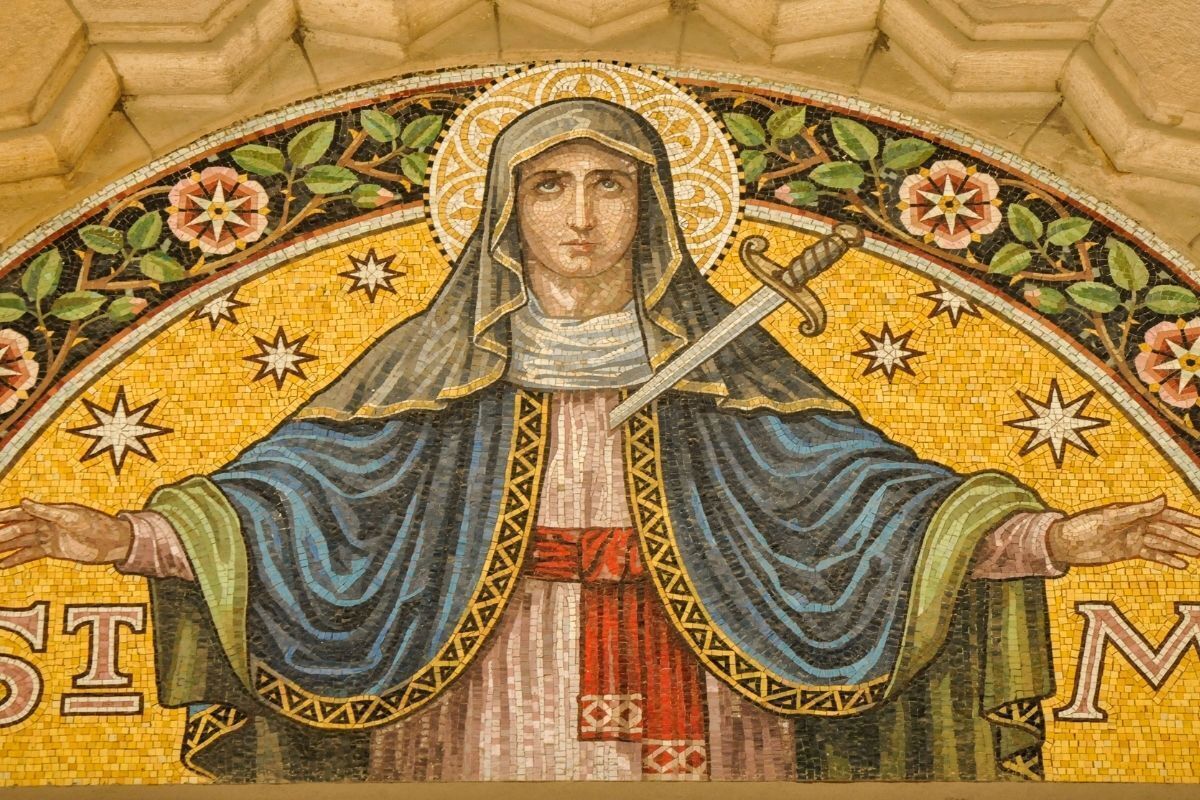
Our Lady of Sorrows is one of the names she received during history. During her earthly life, Mary, the mother of Jesus, went through seven pains, and that is why she received this name. It was during the Passion of Christ, especially, that this reference was highlighted.
It was in Germania, which today is Germany, that this important moment among Catholics began. It is also worth mentioning that the feast of Our Lady of Sorrows is celebrated on September 15. This feast, however, began in Italy. Read on and learn more details about the history of Our Lady of Sorrows.Pain.
History of Our Lady of Sorrows
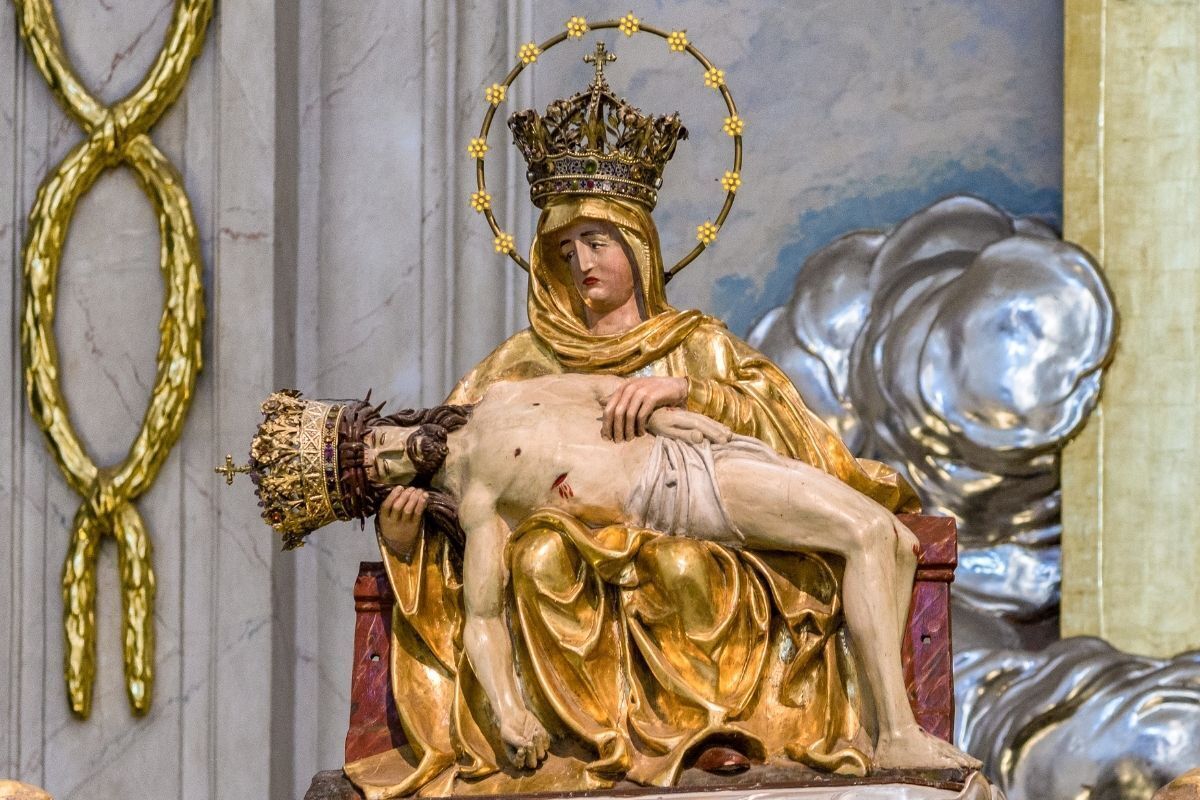
In this topic you will understand more about the history of Our Lady of Sorrows. You will learn about the promises, the meanings, and the participation of Jesus Christ. The company of Our Lady is a remarkable factor for Catholics.
The origin of the cult to Our Lady of Sorrows
The origin of the cult dates back to the last millennium. Devotion to the Mater Dolorosa began in 1221, in Germania, but the Feast had its particular beginning in Florence, Italy, on September 15, 1239. Mary suffered seven sorrows during the Passion of Christ, a period that was historical for the Christian faith.
It was in Germania, a place that today is called Germany, where the monastery of Schönau began this remembrance. The feast, in turn, originated in Florence by the Order of the Servants of Mary (Order of the Servites).
Our Lady of Sorrows, mother of humanity
When Our Lady of Sorrows went through that suffering of seeing her son nailed to the cross, many others were going on. No wonder she is called the Mother of humanity, Jesus Christ being the sacrifice that keeps humanity existing - it is the fruit of Mary's womb that God the Father chose as a miracle.
It was through the Holy Spirit, according to Catholic belief, that she conceived the being who would save our spirits.
Promises to the devotees of Our Lady of Sorrows
St. Bridget received revelations from Our Lady. These revelations have been validated by the Catholic Church. Whoever prays seven Hail Marys will be granted seven graces. She also obtained from her Son that those who spread this devotion will be taken from this earthly life to eternal happiness directly. The seven graces for whoever prays every day are:
- Our Lady will put peace in your families;
- They will be enlightened with the Divine Mysteries;
- She will comfort them in their sorrows and accompany them in their labors;
- She will grant whatever you ask, as long as it does not oppose the will of Jesus Christ and the sanctification of your souls;
- She will defend them from spiritual battles against the infernal enemies and protect them at all times of their life;
- Our Lady will watch the moment of your death and you will be able to see her face;
Promises of Jesus to Saint Alphonsus
The Lord Jesus revealed to Saint Alphonsus some graces for those who are devotees of Our Lady of Sorrows. Saint Alphonsus Maria de Liguori was an Italian bishop, writer and poet. The graces promised were:
- The devotee who invokes the divine Mother through the merits of her Sorrows will, before he dies, make a true penance of all his sins;
- Jesus Christ will place in their hearts the memory of His Passion, giving them the prize of Heaven;
- The Lord Jesus will guard you in all the tribulations of this life, especially at the hour of death;
- Jesus will place them in the hands of his mother, so that she can dispose of them as she pleases and obtain all their favors.
The symbolism of the image of Our Lady of Sorrows
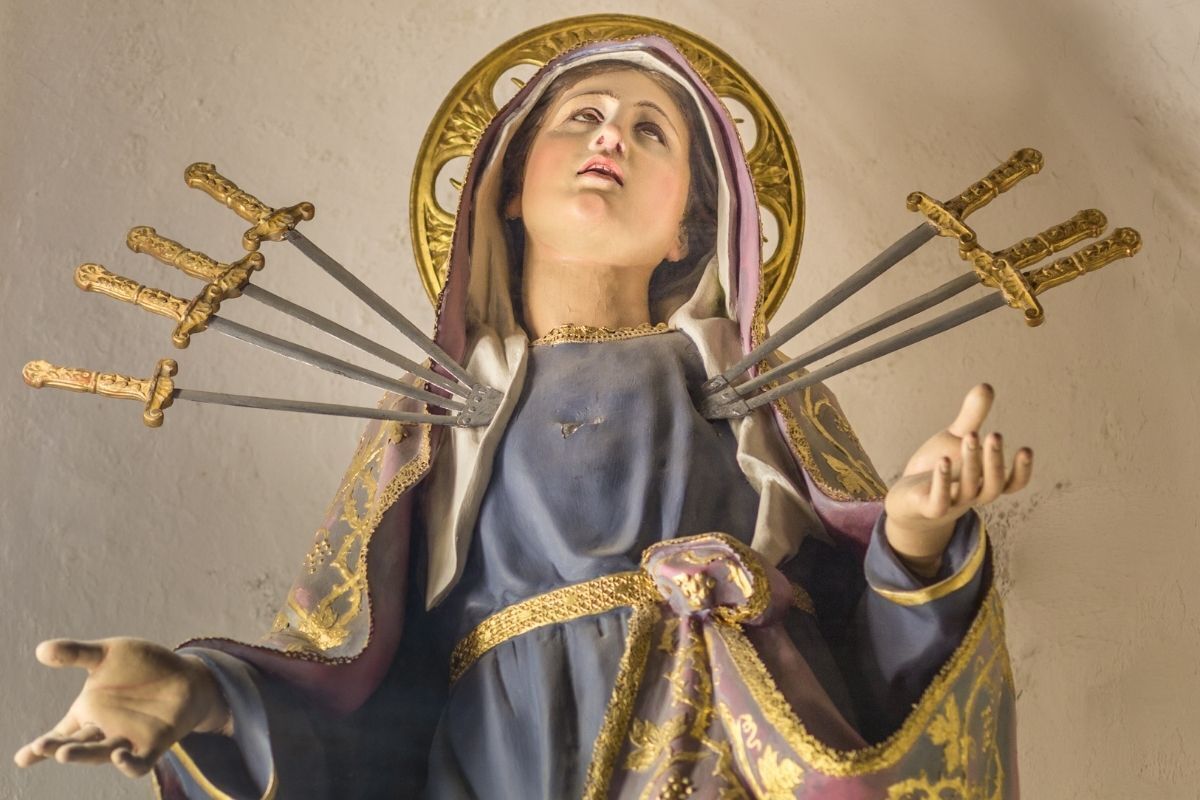
The symbolism in Catholic belief is deep and full of nuances. In this topic you will understand every detail of what the image of Our Lady of Sorrows symbolizes, so read on to learn more.
The blue mantle of Our Lady of Sorrows
The mantle is a garment worn in solemn acts. It is a great sign of dignity and humility. It also symbolizes the separation of the person from the world. Our Lady's blue mantle represents heaven and truth, while the dark blue mantle represents virginity. This, in Israel, was worn by virgin girls.
The word mantle or cloak appears in the Bible a hundred times and is used to cover nakedness, to cover personal intimacy. It was also used as a priestly garment because it indicates preservation, simplicity, stripping of pride and selfishness, humility. All this can represent the mantle, which is also called a veil.
The red tunic of Our Lady of Sorrows
The tunic is an important element for several religions. When it is reddish, it represents the sacred maternity of Our Lady of Sorrows. In Palestine, mothers wore this color to emphasize their maternity. There is also the meaning of the Passion of Christ, because there is much suffering during pregnancy.
Added to the fact that Jesus went through a painful period to save us during his crucifixion, then, the meaning of the veil of Our Lady of Sorrows goes far beyond maternity, as it signifies sacrifice to redeem sins. Thus, the Passion of Christ is related to Our Lady of Sorrows in a legitimate way.
The gold and white in Nossa Senhora das Dores
There are various representations of Our Lady. One of these is the color white and the color gold under the blue veil. The color gold signifies her royalty. This color usually has a respectable and solemn meaning. Everything that has great value receives this color as a representation.
The white is symbolizing, in this context, purity and virginity. The contrast of these colors ends up making the image of Our Lady of Sorrows even more meaningful and enchanting. In short, the colors say that she is: Queen, Mother, and Virgin.
The crown and carnations in the hands of Our Lady of Sorrows
The suffering that Our Lady went through is symbolized with the crown and the nails in her hands. It is related to the suffering that Christ endured to save mankind. It is the ultimate suffering that Our Lady lived and suffered.
In John 19:25, it is reported that Mary stood by the cross. The excess of pain, because of the suffering of her son, is reported and symbolized throughout the Passion of Christ.
The seven swords in the heart of Our Lady of Sorrows
Symbolism is necessary and important for various cultures and religions. Swords are symbols of war, loss, struggle and conquest. In the case of the seven swords in Mary's heart we have, then, a great maternal symbol.
The seven swords correspond to the seven pains that Mary had to go through during her earthly life. All these pains are described and located in the Holy Bible.
The Seven Sorrows of Our Lady
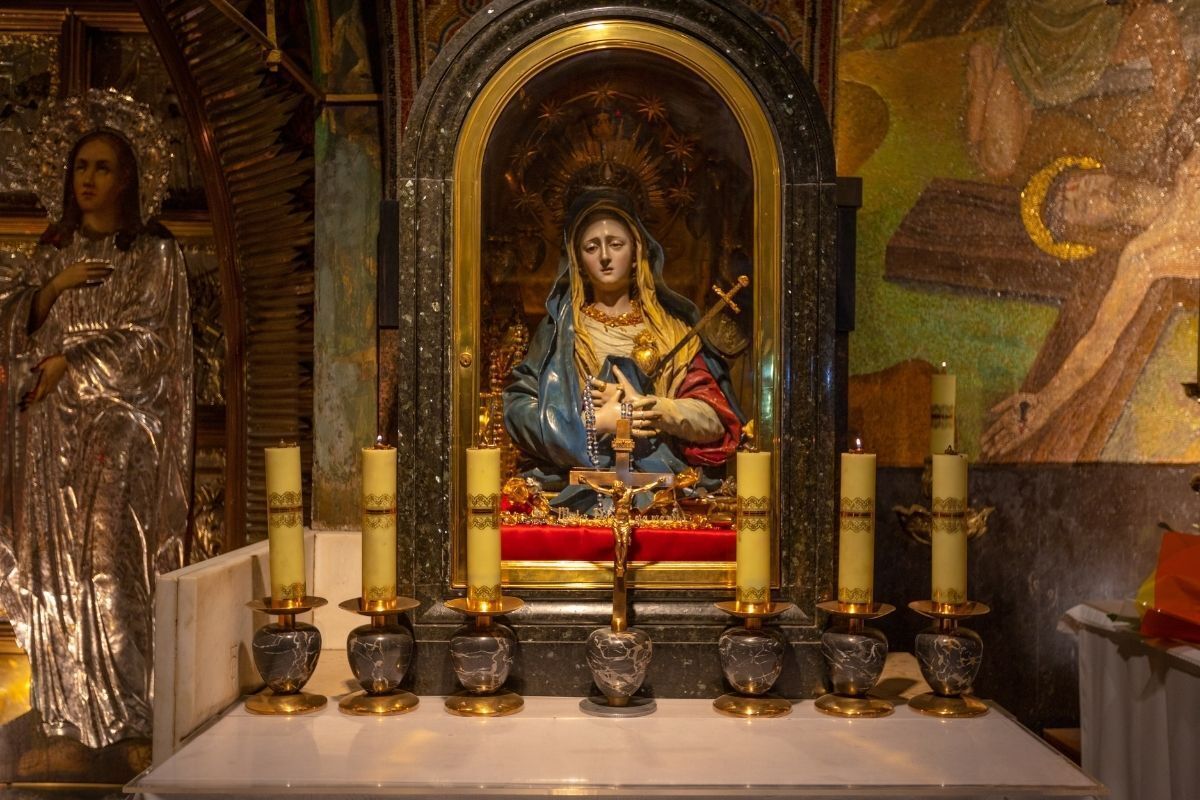
In this topic, you will understand all about the meanings of the period that reflects and names Mary as Our Lady of Sorrows. You will learn about the relationship of these sorrows with that of Jesus Christ. Read on to learn all about it.
The first pain
There were many sacrifices during the time Christ was on earth. The first pain, according to Catholic belief, is related to what the Prophet Simeon said. He said that Mary's son would receive a sword of pain in his heart. This made her suffer.
The prophets of the past had a very high degree of gauge. They were in contact with God in a very direct way and, because of this, they got divine answers to their afflictions. This Bible passage can be found in Luke 2:28-35. We have, with this, the first sorrow reported. This revelation signaled that bad things would happen to his son Jesus.
The second pain
Imagine yourself, with a child on your lap, having to flee to countries completely different from your culture, so that your child would not be murdered by order of a king. This, according to Catholic belief, is the second sorrow of Our Lady. The Holy Family fled to Egypt shortly after hearing Simeon's prophecy.
Herod had heard about the prophecy that a new king would rule everything and everyone. The angel warned Mary to flee and not to accept what Herod had proposed, she kept the angelic words, and fled. So, for four years, Jesus and his family developed in Egypt.
The third pain
The third pain is related to the fact that the child Jesus was lost during a caravan. When he was 12 years old, he took part in a Passover pilgrimage. Afterwards, everyone returned home except Jesus, because he was arguing with the Doctors of the Law. In the meantime, he disappeared for three days. Mary was clearly distressed by this situation.
When Jesus returned to his home, he said that he needed to take care of his Father's things. It was a great lesson and a warning to Mary of all that was about to happen. Her son was clearly not like the others, and his destiny was to be completed.
The fourth pain
After all the good deeds that Jesus did for humanity, he was unjustly condemned. This period was of great pain and suffering for the holy family. Jesus was condemned as an outlaw, and Mary saw all of this happening up close. In tears, she was with him until the last moment.
The fourth sorrow is connected to the suffering before the crucifixion. No mother, even when her son is guilty, is able to see such suffering of a son. But this is how it was meant to be, and because of this sacrifice mankind received its last chance for redemption.
The fifth pain
When Mary sees her son crucified, we have, therefore, the fifth sorrow. After all the suffering that Jesus went through, Mary experiences the consummation of what Simeon had predicted. There is nothing more cruel than to see your only son being crucified. No mother could bear it. Even more so in the case of Jesus, who only did good during his time here on earth.
This is the fifth and most painful pain. The whole body of Christ had been pierced, and Mary's heart had also been pierced. Every wound that was opened in Christ's body also opened in the heart of Our Lady of Sorrows.
The sixth pain
To make sure that Jesus was really dead, a spear was thrust through his body. It is written that blood and water gushed out. And, closely, Mary followed everything standing near the cross. We have, then, the sixth sorrow of Our Lady of Sorrows, according to Catholic belief. The moment of Christ's death is one of great commotion.
However, the promise of the resurrection made the hope of seeing him again a relief. But before that, we have the seventh and last pain. It is from the end of the pains that hope for eternal redemption grows.
The seventh pain
The seventh sorrow is connected with the burial of Jesus Christ. They took his body and laid it in swaddling clothes with the spices, just as the Jews used to do. Jesus was buried in a garden in the place where he was crucified. In this place no one had ever been buried. It was a new tomb.
And in the garden, they raised a stone and placed the body of Christ. St. Bonaventure said that Our Lady, before leaving the place of the sepulcher, blessed the stone. According to Catholic belief, this stone became sacred. Mary, Our Lady of Sorrows, leaves devastated, bidding farewell to her Son.
Devotion to Our Lady of Sorrows
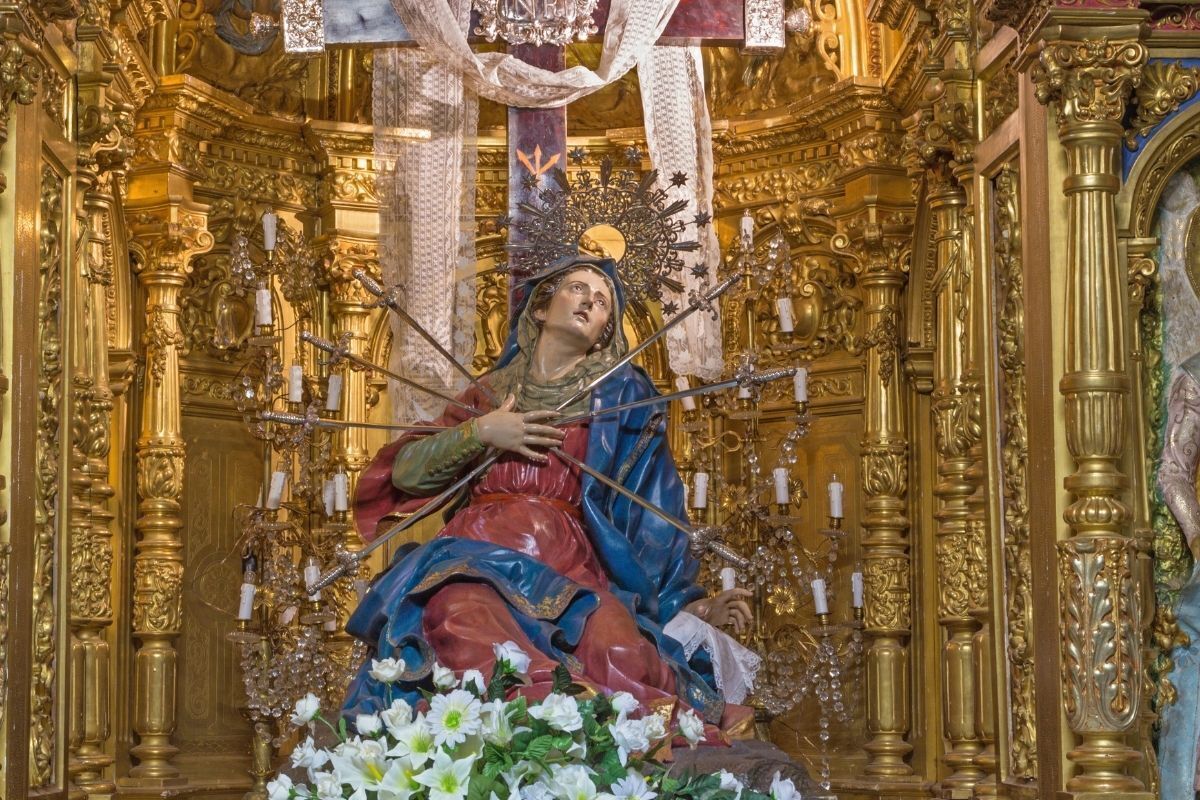
The devotion to Our Lady of Sorrows happens with prayers. The meditation consists of praying an Our Father and seven Hail Marys after each pain. In this topic you will understand about the miracles, the day, and how to pray.
Miracles of Our Lady of Sorrows
One of the best known miracles of Our Lady of Sorrows is that of the volcano in the Canary Islands. A Franciscan called Catholics to a procession with the image of the Virgin of Sorrows to stop the lava flows.
A few days went by, and nothing seemed to resolve the dangerous situation, until a grieving woman came up to a girl tending the goat herd and said:
"Daughter, go and tell your parents to talk to the neighbors to build the shrine, otherwise the volcano will erupt once again."
The parents didn't believe it when the little girl first told them. Then the woman appeared again to the little girl, and told her to talk to her parents again. A hand was placed on the girl's shoulder as she told her parents about the woman. Impressed, they took the little girl to the Mother Church. And they began the construction.
The day of Our Lady of Sorrows
Every September 15, the Catholic Church celebrates two feasts to Our Lady of Sorrows. This celebration is a very important event, and serves to remember all the pains that Mary went through during her life when she saw her Son being unjustly sacrificed.
It is a time for meditation and deep prayer. This celebration began in 1727, by Pope Benedict VIII. One of the feasts is celebrated on the first Friday of the week, and the second is on the 15th.
Our Lady of Sorrows Prayer
The prayer to Our Lady of Sorrows is simple and practical. Through the repetition of Hail Marys and only one Our Father, it will be possible to say this important prayer correctly. So let's go: first the Our Father, and then 7 Hail Marys for each pain that Our Lady of Sorrows had to go through.
The sorrows are: the prophecy of Simeon, the escape into Egypt, the three days that Jesus was lost, the meeting with Jesus carrying the cross, His death on Calvary, the lowering of the cross and the burial of Jesus. These are the 7 sorrows.
How does Our Lady of Sorrows help her faithful?
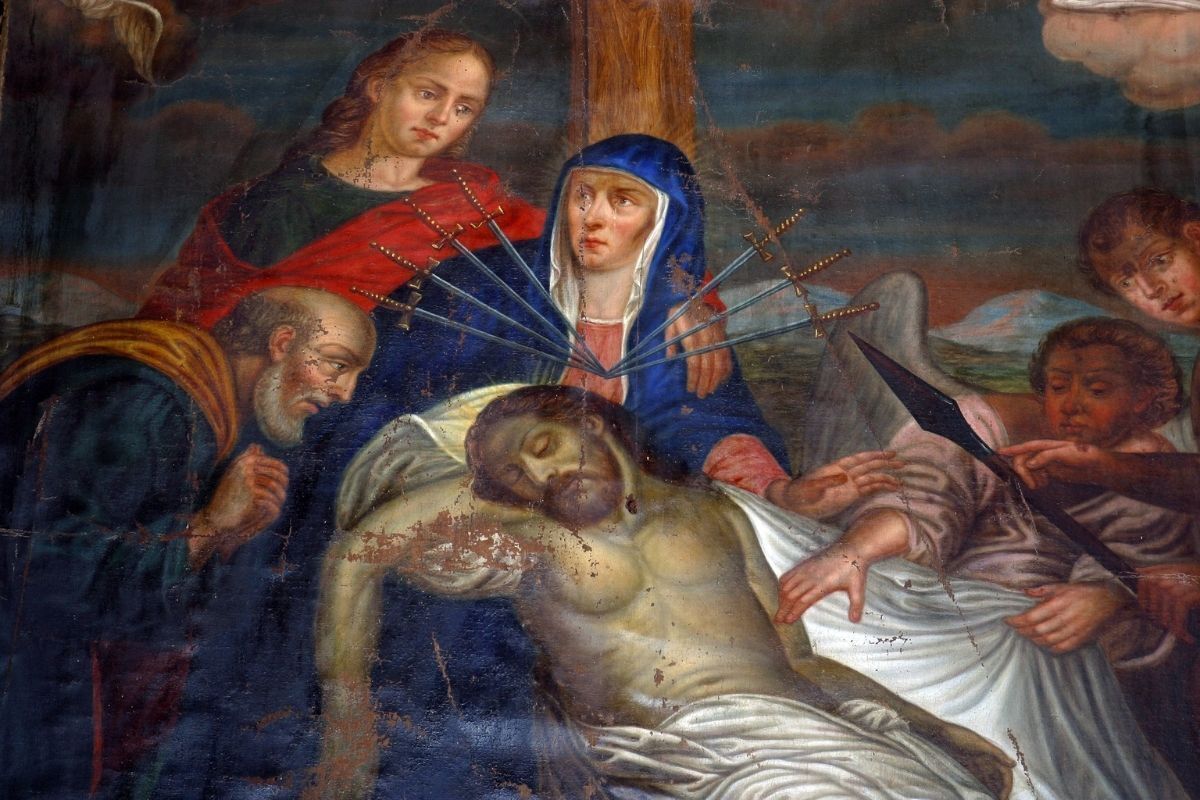
Through promises to those who pray the rosary of Our Lady of Sorrows, it is possible to receive help from her. To do so, ask with all your heart, faith, and intention. As it was possible to analyze, Our Lady of Sorrows intercedes for her children to bring peace in all families, consoling each one of her faithful, helping in all occasions that do not hinder their spiritual evolution.
In this way, with much light, Our Lady of Sorrows will shine on her paths, delivering her devotees from all spiritual enemies, even in matters in which you felt wronged.
In addition, one of the promises reveals that at the moment each one leaves for the other dimension of spiritual life, at the time of death, it will be she who will take care of your spirit, when it will be possible to see your face.

